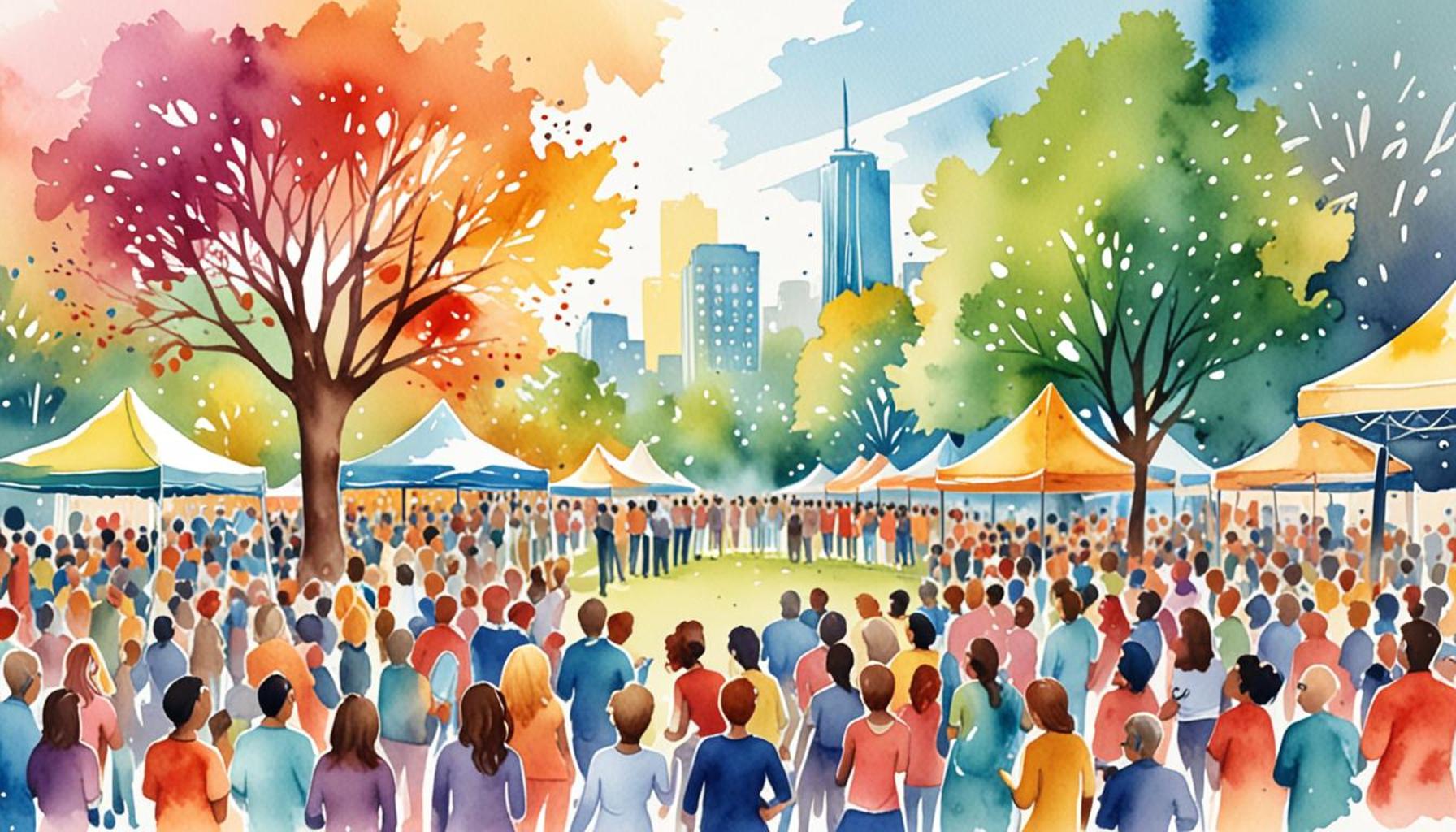How Community Events Can Raise Awareness of Public Benefits

Engaging Communities for Greater Good
Community events are more than just social gatherings; they are vital mechanisms that strengthen the fabric of local society. By aligning various public services with the needs of residents, these events create a unique opportunity for education, networking, and meaningful engagement. From small neighborhood picnics to large-scale community fairs, these activities encourage participation and drive awareness of the essential services available to the community.
One prevalent way community events promote public benefits is through Education. For instance, workshops and seminars led by experts can focus on topics such as nutrition, financial literacy, and mental health, equipping attendees with practical knowledge that can enhance their quality of life. Informational booths staffed by local service providers at farmers’ markets or health fairs can help demystify complex programs like SNAP (Supplemental Nutrition Assistance Program) or Medicaid, inspiring residents to take advantage of these resources.
In addition to education, Networking is another pivotal aspect of community events. They offer individuals a chance to interact directly with local leaders, nonprofit organizations, and government officials. For example, town hall meetings facilitate open dialogues where citizens can share their concerns and learn about proposed initiatives that might address community needs. These types of interactions strengthen relationships and build trust, making citizens feel more connected to their community and its governance.
Moreover, such events foster Engagement through hands-on activities that captivate participants. For instance, a community clean-up day encourages volunteers to take part in beautifying their neighborhood, instilling a sense of pride and ownership. Similarly, family-friendly festivals featuring games, music, and food not only entertain but also educate families about public health resources and educational programs available to them. Engaged participants are more likely to actively seek and utilize public services, which can help reduce disparities in access and support.
Throughout the United States, a variety of initiatives illustrate the effectiveness of these community gatherings. Take health fairs, for example, which effectively highlight services ranging from immunizations to chronic disease management. In many cases, attendees leave empowered with knowledge about future health screenings and wellness resources. Similarly, community markets often provide information not only on nutrition but also on local educational resources, such as after-school programs or adult education classes. By bridging these services with personalized outreach, communities can make a significant difference in the lives of families.
Ultimately, the importance of community events cannot be overstated. They serve as powerful vehicles for enhancing awareness and understanding of available public benefits. With a commitment to fostering inclusive engagement, communities can thrive and overcome challenges. Join us in exploring the myriad ways these gatherings unite residents and promote vibrant, informed communities eager to advocate for their needs.
RECOMMENDED: Check out this similar article
Unlocking Community Potential Through Awareness
Community events provide a dynamic platform for organizations and individuals to disseminate information about public benefits that might otherwise remain underutilized. These gatherings are essential to fostering an understanding of available resources within the community. With careful planning and outreach, event organizers can transform casual interactions into significant learning experiences, thereby amplifying the outreach of public services.
One effectual method of raising awareness about public benefits at community events is through engaging interactive demonstrations. For example, interactive health workshops can include live cooking demonstrations, where nutritionists showcase how to prepare healthy, affordable meals using food from local food banks. This not only illustrates the availability of benefits like SNAP, but also empowers attendees to make informed choices that can lead to improved long-term health.
To successfully highlight public services, community events often feature a variety of informative activities, such as:
- Panel discussions: These sessions can bring together experts and community leaders to discuss critical issues like education and housing assistance.
- Q&A sessions: Residents can ask questions and get immediate answers, clarifying any doubts about benefit eligibility and application processes.
- Resource fairs: Organizers can set up booths that showcase different organizations and the services they offer, such as job training programs, childcare assistance, and healthcare access.
The accessibility of such information at community events cannot be overstated. In 2021, a report by the National Association of Counties found that outreach during neighborhood festivals increased public participation in various social programs by over 35%. When residents can learn about their rights and resources in a relaxed and welcoming environment, they are more likely to engage with social support programs that can have a lasting impact on their quality of life.
Local governments and nonprofit organizations often collaborate to facilitate these events, pooling their resources for a more significant communal impact. Events are planned with specific public benefits in mind, ensuring that the communal needs are met. For instance, while a back-to-school celebration might focus on educational resources, a health fair could emphasize access to medical services and wellness programs.
The ripple effects of raising awareness through community events extend far beyond the immediate benefits. As community members familiarize themselves with available resources, they often become advocates themselves, spreading the knowledge within their networks. This grassroots approach to improving public knowledge about available benefits creates a much more informed populace that is empowered to utilize those resources effectively.
As we delve deeper into the myriad ways community events raise awareness of public benefits, we will uncover how these gatherings can truly transform the lives of residents and strengthen societal bonds in a profound and positive way.
How Community Events Can Raise Awareness of Public Benefits
Community events play a pivotal role in fostering community engagement and driving public awareness about essential services and resources. They serve as a platform for local officials and organizations to present their initiatives and solicit public input, effectively bridging the gap between the governance and the community it serves. In this engaging realm of social interaction, residents not only gain insights into public benefits available to them, but they also develop a sense of ownership and responsibility towards their community.Furthermore, these gatherings can enhance social cohesion by bringing together diverse demographics, thereby increasing participation in public programs and services. For instance, local health fairs may showcase free public health resources, contributing significantly to preventive care awareness. A study by the National Institute of Health indicates that such events can increase public health knowledge by up to 60%, highlighting their function as vital educational tools.Additionally, the art of storytelling in community events can profoundly impact public perception of government initiatives. Engaging presentations from beneficiaries of public programs can create relatable narratives that inspire others to seek assistance, thus dismantling stereotypes that may hinder participation. To illustrate this point further, consider community festivals where local nonprofits offer engaging demonstrations about public services, from recycling initiatives to zoning regulations. These lively and informative exchanges not only inform but also foster discussions around community development and improvement.To delve deeper into the specific advantages and categories of community events that amplify public benefits, refer to the table below which summarizes key insights.
| Category | Description |
|---|---|
| Education | Community events educate residents about public services like healthcare and housing. |
| Engagement | These events encourage citizen participation and feedback on local initiatives. |
| Networking | They facilitate connections among residents, local leaders, and organizations. |
The dynamic nature of community events is not just limited to their immediate impacts but also plants the seeds for long-term benefits by nurturing a culture of cooperation and collaboration among residents. As communities forge stronger ties through these interactions, the likelihood of successful implementation of public benefits significantly increases, demonstrating the profound influence of grassroots initiatives.
SEE ALSO: Click here to read another article
Building Bridges Between Services and Citizens
One of the most intriguing aspects of community events is their potential to serve as a bridge between public services and the citizens who need them most. By offering events that cater to the unique needs of the local population, organizers can tailor their approach to ensure that specific public benefits are emphasized. For instance, during tax season, community organizations may host free tax preparation workshops that inform attendees about eligibility for various programs like the Earned Income Tax Credit (EITC) or state-specific tax relief initiatives. This kind of direct engagement helps alleviate confusion surrounding often complex systems of assistance, making them more accessible to those who might be skeptical or unaware of their options.
Furthermore, leveraging local leaders and trusted community figures can significantly enhance the credibility and effectiveness of these initiatives. When respected local figures—be they school principals, clergy members, or even local business owners—speak out on behalf of various programs, residents are more likely to engage. For example, a local pastor discussing the importance of food security programs during a church gathering can spur conversations and encourage individuals to access available resources, thereby raising critical awareness of programs like the Supplemental Nutritional Assistance Program (SNAP).
Innovative Uses of Technology
In an increasingly digital world, community events are also adapting by integrating technology into their outreach strategies. Many organizations are utilizing social media platforms to amplify the reach of their events and the benefits being showcased. This includes live streaming workshops, sharing information via posts and stories, or even creating event-specific hashtags that encourage community members to share their insights and experiences. According to a 2022 study by the Pew Research Center, approximately 70% of Americans use social media to connect with community events and organizations. By capitalizing on this trend, organizers can engage a broader audience, including younger generations who may otherwise not participate in traditional formats.
Avenues for Collaboration
Collaboration is key in maximizing impact. By partnering with local businesses, government agencies, and nonprofits, community events can offer a wider array of services and resources. For instance, a multi-agency fair might include booths from healthcare providers, legal aid organizations, and employment agencies, providing a one-stop-shop for residents. Such collaborative efforts not only streamline access to public benefits but also foster community spirit and cooperation. Statistics from the Urban Institute indicate that communities exhibiting high levels of collaboration experience a 25% increase in the utilization of public resources.
Additionally, follow-up initiatives post-events play a crucial role in maintaining engagement. Creating newsletters or community bulletins that summarize what was learned and provide further resources can keep the momentum alive and remind individuals that support is ongoing. Sustained communication ensures that the knowledge shared during community events transitions from a one-day affair to a lasting change in awareness.
As more organizations realize the significant impact that tailored, well-planned community events can have on raising awareness of public benefits, the potential for improved service utilization becomes clearer. These gatherings not only create an environment for learning and connection but also catalyze the ongoing advocacy for community needs. By continuously fostering an informed population, communities can work towards dismantling barriers to accessing essential public benefits, ultimately leading to healthier, more equitable societies.
CHECK OUT: Click here to explore more
Conclusion: Empowering Communities Through Awareness
In conclusion, community events serve as a vital mechanism for bridging the gap between public benefits and the individuals and families who stand to gain from them. By utilizing innovative strategies such as collaboration with local leaders, integrating technology, and fostering inclusive environments, these gatherings have the power to engage citizens in ways that traditional outreach often cannot. The statistics highlight that communities with collaborative efforts experience a marked increase in public resource utilization, underlining the effectiveness of coordinated initiatives.
Moreover, the importance of not only raising initial awareness but also maintaining ongoing engagement cannot be overstated. By implementing follow-up strategies, such as newsletters and community bulletins, organizers can ensure that the dialogue established during events continues long after the last session ends. This sustained communication transforms individual events into a series of proactive steps toward building an informed and empowered community.
As the landscape of public benefits continues to evolve, it is imperative that community events adapt alongside these changes. The potential for improved societal outcomes through informed participation is more significant than ever. Stakeholders, from local governments to nonprofits and businesses, must recognize their role in facilitating these interactions. By doing so, they contribute to the creation of resilient communities characterized by greater access to vital resources, ultimately fostering a healthy, equitable society for all. Engaging in these initiatives today can pave the way for a brighter, well-informed tomorrow.


